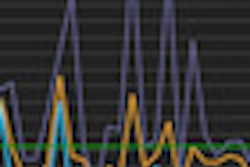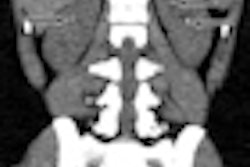A new meta-analysis of lung cancer screening studies shows that only one of three randomized trials that looked at mortality found a benefit from lung cancer screening. Still, the comparison is questionable inasmuch as two studies analyzed along with the National Lung Screening Trial (NLST) may be too small, and the follow-up periods too short, to show any mortality difference even in the best of circumstances.
In their analysis, researchers from Columbia University Medical Center found that only NLST showed a mortality benefit for low-dose CT lung cancer screening compared to radiography. Two much smaller trials showed no mortality benefit compared to usual care that forgoes routine CT screening.
"CT screening reduced risk for all-cause and lung cancer mortality more than chest radiography in the largest trial; CT screening and usual care did not differ in two trials," wrote Dr. Alfred Neugut, PhD, and Dr. Melissa Accordino (Annals of Internal Medicine, September 18, 2012, Vol. 157:6, pp. JC3-6).
The results were no great surprise, considering that the other studies were too small and did not have long enough follow-up to show a mortality benefit from screening, said lung cancer screening expert Dr. Claudia Henschke in an interview with AuntMinnie.com.
Citing NLST, which showed a mortality benefit after examining more than 53,000 patients, "they enrolled people from 2004 to 2006 and waited six years after the last screening to look at mortality," said Henschke, who is a professor of radiology and head of the lung and cardiac screening program at Mount Sinai Medical Center. On the other hand, the two studies to which it was compared enrolled about 3,300 subjects between them and analyzed lung cancer incidence three to five years after the initial scan.
"They can't conceivably have had a long enough follow-up," she said.
Studies aiming to show mortality benefit from screening must typically examine tens of thousands of patients and follow them for many years at a cost of hundreds of millions of dollars. "It's almost a national project," she said.
Assessing mortality benefit
For their analysis, Neugut and Accordino performed an online search of lung cancer screening trials that were restricted to age and smoking history as risk factors. They looked for reported lung-cancer-specific or all-cause mortality, nodule detection rate, frequency of additional imaging and invasive diagnostic procedures, and complications from the evaluation of CT-detected nodules.
They found eight randomized, controlled trials encompassing more than 83,000 patients and 13 cohort studies that met the inclusion criteria. Only the randomized trials were included in the analysis; five of these compared low-dose CT with no screening and three with chest radiography. Four randomized trials reported preliminary data, and three reported mortality.
Of the three randomized, controlled trials in the analysis that measured mortality, only one, NLST, showed a statistically significant benefit from lung cancer screening, the authors concluded. The other two trials, both of which compared lung cancer screening to usual care, showed no mortality benefit. The other two trials were:
- The Detection and Screening of Early Lung Cancer by Novel Imaging Technology and Molecular Essays (DANTE) trial (American Journal of Respiratory and Critical Care Medicine, September 1, 2009, Vol. 180:5, pp. 445-453) scanned 1,276 subjects with low-dose CT, with 1,196 in the control group. Over a median follow-up of 33 months, 60 lung cancer cases were detected. More screening cases with stage 1 disease were detected with low-dose CT; however, the number of advanced cases was the same in the screening group as in the control arm, Dr. Marizio Infante and colleagues wrote.
The Danish Lung Cancer Screening Trial (DLCST) (Journal of Thoracic Oncology, May 2009, Vol. 4:4, pp. 608-614) scanned 2,062 participants at baseline; of these, 179 had a nodule 5 mm or larger, and most were rescanned. In all, 17 patients (0.8%) had lung cancer, including 10 with stage 1 disease, Pederson and colleagues reported.
According to a 2012 analysis in Thorax (April 2012, Vol. 67:4, pp. 296-301), the mean annual detection rate was 0.67% in five incidence rounds (p = 0.535). More lung cancers were diagnosed in the screening group than in the control group (69 versus 24, p < 0.001), and more cancers in the screening group were low- and limited-stage cancers. However, the frequencies of high-stage lung cancer were the same in both groups (p = 0.509). At the end of screening, 15 screening patients and 11 control patients died of lung cancer, Saghir and colleagues reported.
An expected result
Addressing the equivalent number of early-stage and advanced cancers in DLCST, Henschke said the phenomenon is to be expected for several years after the screening rounds end as the early cancers work their way through the population. The same thing occurred in NLST, where it took six years after the last screening round to show a 20% mortality benefit. In contrast, DLCST just completed its last screening round in 2011, and the DANTE analysis occurred after a median 33 months of follow-up.
"No. 1, the follow-up it too short, and No. 2, the cohort is too small," Henschke said.
"Claudia is right -- it is the NLST that is the primary and definitive study here," Neugut responded in an email to AuntMinnie.com. "The others are secondary." Neugut is a professor of medicine at Columbia University College of Physicians and Surgeons.
Lung cancer mortality in 3 randomized trials
|
||||||||||||||
All-cause mortality rates were similar for screened versus unscreened populations: 3.6% (screened) versus 3.8% (comparator) for DANTE and 3.0% (screened) versus 2.0% (comparator) for DLCST.
CT screening reduced risk for all-cause and lung cancer mortality more than chest radiography in the largest trial (NLST); however, CT screening and usual care did not differ in the other two trials, Neugut and Accordino concluded. The average nodule detection rate in the eight randomized, controlled trials was 20% (range, 3% to 30%). In six randomized trials, including all three that compared CT to chest radiography, 90% of nodules were benign.
"Experts have awaited the results of the National Lung Screening Trial, which, as described in the review by Bach and colleagues, showed a 20% reduction in lung cancer mortality and a number needed to screen [to find a single cancer] of 320 in heavy smokers," Neugut and Accordino wrote. "These results are similar to those estimated for routine mammographic screening for breast cancer in women in their 60s."
NLST as reviewed by Bach et al showed a good safety profile and a low risk of future radiation-induced cancers, leading the American College of Chest Physicians and the American Society of Clinical Oncology to recommend low-dose CT screening for individuals meeting the NLST criteria.
In their conclusion, Neugut and Accordino took issue with Bach et al's recommendation that screening only occur in high-volume academic centers, probably, they said, due to Bach et al's concerns about nodule management. There is no evidence that such a restriction would result in better management of detected nodules, according to the authors.
"Changing the norms of clinical practice and follow-up evaluation would be preferable to restricting the setting for screening tests," Neugut and Accordino wrote.
Henschke noted that while these trials are too small to show a mortality benefit from screening, the NELSON lung cancer screening trial in Europe, with 15,000 participants, may be large enough to show a mortality benefit when the results are finally reported in 2015. DLCST was designed from the start to be incorporated into the NELSON results, she added.




















